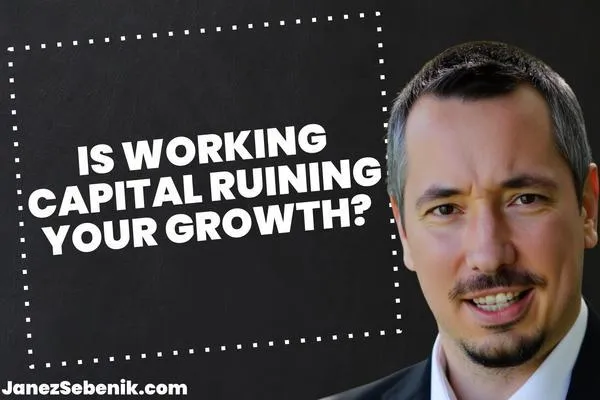
What are the disadvantages of working capital management?
Working capital management sounds fancy, but it's got a dark side. You might think it's all about keeping your business running smoothly. But here's the kicker: it can trip you up if you're not careful.
Too much focus on working capital can lead to missed opportunities and stunted growth. It's like trying to walk a tightrope while juggling flaming torches. Sure, you might keep your balance, but you're not getting anywhere fast.
You've got to watch out for the hidden costs too. Managing working capital takes time and resources. It's not just about crunching numbers. It's about making tough calls that could impact your whole business. And sometimes, those calls might not pay off.
Key Takeaways
Balancing working capital can limit growth and innovation
Managing working capital comes with hidden costs and risks
Overemphasis on short-term liquidity may harm long-term success
Tightrope of Liquidity
Managing working capital is like walking a tightrope. You gotta balance keeping enough cash on hand with using it to grow your business. It's tricky, but get it right and you'll crush it.
The Liquidity-Consistency Conundrum
You want to be liquid, but not too liquid. It's a balancing act. Too much cash sitting around? You're missing out on growth opportunities. Too little? You might not be able to pay your bills.
Your liquidity ratios are key here. The current ratio and quick ratio tell you if you've got enough short-term assets to cover your short-term debts.
But here's the kicker: these ratios can change fast. One big purchase or unexpected expense can throw everything off.
So you gotta keep a close eye on them. Daily, even. It's a pain, but it's necessary.
Cash Flow Challenges
Cash flow is king. But managing it? That's where things get messy.
You might be profitable on paper, but if you can't collect your receivables, you're in trouble. Late-paying customers can wreck your cash flow.
And don't forget about timing. You need to pay your suppliers before your customers pay you. That gap? It can kill your business if you're not careful.
Working capital management means juggling all these balls. It's exhausting. But if you drop one, your whole business could come crashing down.
Risks in Ratio Mismanagement
Get your ratios wrong, and you're in for a world of hurt.
Your working capital ratio should be between 1.5 and 2. Lower? You might not be able to pay your bills. Higher? You're probably not using your assets efficiently.
But it's not just about hitting a number. You need to understand what's behind it.
Are your inventory levels too high? That ties up cash. Are your receivables taking too long to collect? That's a cash flow problem waiting to happen.
And don't forget about industry standards. What's good for a tech startup might be terrible for a manufacturing company.
Get it wrong, and you could find yourself in a liquidity crisis. Not fun.
The Cost Factor
Managing working capital isn't free. It's like trying to juggle while riding a unicycle - tricky and expensive. You'll face opportunity costs and potentially high interest on short-term debt. Let's break it down.
Opportunity Wastes
You know that cash sitting idle in your business? It's not working for you. It's like having a Ferrari and never driving it. That money could be invested in growth opportunities or equipment upgrades.
Every dollar tied up in inventory or unpaid invoices is a dollar not making you more money. It's a missed chance to expand, innovate, or boost your marketing.
You're essentially paying for the privilege of having that working capital. And sometimes, the cost outweighs the benefits. It's like paying for a gym membership you never use.
High Interest on Short-Term Debt
Short-term debt can be a lifesaver for your working capital needs. But it comes at a price. And that price is often sky-high interest rates.
You might need to take out loans to cover payroll or buy inventory. These loans usually have higher interest rates than long-term debt. It's like using a credit card instead of a mortgage.
The more you rely on short-term debt, the more you'll pay in interest. It's a slippery slope. You could end up spending more on interest payments than you're making in profits.
And don't forget about those pesky short-term obligations. They can pile up fast, leaving you scrambling to meet payments. It's like trying to outrun a avalanche - scary and potentially disastrous.
Supply Chain Snags
Supply chain problems can wreak havoc on your working capital. They mess up your inventory and make you too reliant on suppliers. Let's break it down.
Inventory Inefficiency
You know what sucks? Having too much stuff sitting around. It ties up your cash and collects dust. But not having enough? That's even worse. You'll miss out on sales and disappoint customers.
Just-in-time (JIT) inventory sounds great in theory. But when supply chains get wonky, it can bite you in the butt. You're left scrambling to find materials or finished goods.
Inventory management becomes a nightmare. You're either overstocking to play it safe or risking stockouts. Either way, your working capital takes a hit.
Supplier Dependency
Relying too much on a few suppliers? That's a recipe for disaster. When they sneeze, you catch a cold.
If your supplier can't deliver, you're stuck. Your production grinds to a halt. Customers get angry. Cash flow dries up.
Dealing with multiple stakeholders in the supply chain is tough. Everyone wants different payment terms. You're juggling to keep everyone happy while watching your working capital.
Diversifying suppliers sounds smart, but it's not always easy. It takes time and money to build new relationships. And you might lose volume discounts. It's a balancing act that can strain your resources.
Profitability Pressures
Working capital management can be a double-edged sword for your business. It's like trying to juggle flaming torches while riding a unicycle - one wrong move and you're toast.
Profit Margin Pitfalls
You want to make money, right? But too much focus on working capital can bite you in the butt. Keeping too much inventory ties up cash. It's like having a garage full of stuff you can't use.
Too little inventory? You might miss sales. Ouch.
Strict credit policies can scare off customers. But loose ones? You might as well be handing out free money.
Return on capital can take a hit if you're not careful. It's a delicate balance, like walking a tightrope in high heels.
Accounts Receivable Anxieties
Late payments are the bane of your existence. They're like that friend who always "forgets" their wallet.
Your collection ratio might look good on paper, but what about the real world? Chasing payments is like herding cats - frustrating and time-consuming.
Days sales outstanding can creep up on you. It's like watching paint dry, but with more financial consequences.
A strict credit policy might keep your receivables in check, but it could also choke your sales. Talk about being stuck between a rock and a hard place!
Growth Gaps
Working capital management can create some tough tradeoffs. You might have to choose between short-term stability and long-term growth. It's not always easy to find the right balance.
Sacrificing Expansion
You want your business to grow, right? But managing working capital can sometimes get in the way. When you focus too much on short-term cash flow, you might miss big opportunities.
Keeping lots of cash on hand feels safe. But what if that money could be used to expand into new markets? Or develop a game-changing product?
You could be leaving money on the table. Your competitors might zoom past you while you're playing it safe. It's a classic case of short-term thinking vs. long-term vision.
Capital Allocation Concerns
Where should you put your money? It's not always clear. Too much working capital ties up funds that could be used elsewhere.
You might be missing out on:
Investing in new equipment
Hiring top talent
Marketing campaigns that could explode your growth
Small businesses often struggle with this. They need cash for day-to-day operations. But they also need to invest in growth.
It's a balancing act. Too little working capital, and you might not survive. Too much, and you might not thrive. You've got to find that sweet spot.
Financial Health Hazards
Working capital management can be tricky. When done wrong, it can seriously mess up your company's financial health. Let's dive into the dangers lurking in aggressive strategies and solvency struggles.
Impact of Aggressive Strategies
Aggressive working capital management might sound cool, but it's like playing with fire. You're walking a tightrope between efficiency and disaster.
Pushing your inventory turnover ratio to the max? Sure, it looks great on paper. But what happens when you can't meet sudden demand? You're toast.
Stretching out your accounts payable terms? Careful there, cowboy. Your suppliers might get antsy and cut you off.
And don't get me started on slashing your cash reserves. One hiccup in cash flow, and you're scrambling for spare change in the couch cushions.
Remember, aggressive doesn't always mean smart. Sometimes, it just means you're asking for trouble.
The Solvency Struggle
Solvency is like oxygen for your business. Without it, you're gasping for air.
Poor working capital management can leave you drowning in debt. Your balance sheet starts looking like a horror story.
You might think you're being clever by maxing out trade credit. But when creditors come knocking, and your cash flow is a trickle? That's when the real panic sets in.
And here's the kicker: insolvency doesn't just happen overnight. It's a slow burn, eating away at your financial health until - boom! - you're toast.
Don't let short-term gains blind you. Keep an eye on those ratios, buddy. Your future self will thank you.
Relationship Ripples
Working capital management can mess with your business relationships. It's not all sunshine and rainbows. Let's dive into how it can stir up trouble with your suppliers and customers.
Accounts Payable Tension
You know those folks you owe money to? Yeah, they might not be thrilled if you're taking too long to pay. Stretching out payment terms can boost your working capital, but at what cost?
Your suppliers might start giving you the side-eye. They could:
Jack up their prices
Demand cash on delivery
Stop giving you those sweet discounts
It's like playing chicken with your business partners. You're trying to hold onto cash, but they're getting antsy.
And here's the kicker: if you push too hard, they might just stop working with you altogether. Ouch!
Straining Business Goodwill
Now, let's talk about your customers. You're trying to collect cash faster, right? But pushing too hard can backfire big time.
Tightening your accounts receivable might look good on paper. But your customers? They might start feeling the squeeze.
You could end up:
Losing loyal customers
Getting a reputation as a hard-ass
Missing out on future business opportunities
It's like trying to squeeze blood from a stone. You might get some short-term cash, but at what cost to your reputation?
Remember, business is all about relationships. Push too hard on either end, and you might find yourself with fewer friends in the business world.
